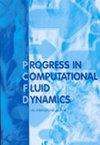Aerodynamic design and computational fluid dynamic analysis of radial outflow turbines for steam Rankine cycle and supercritical carbon dioxide Brayton cycle
IF 0.5
4区 工程技术
Q4 MECHANICS
引用次数: 0
Abstract
The first part of this paper presents the design of a radial outflow steam turbine for a micro steam power pump block of 200 kW capacity based on a unique Ljungstrom turbine design methodology. Computational fluid dynamic (CFD) simulations were carried out for the 18-stage radial outflow steam turbine at design and off-design points, and results proved the validity of the undertaken design methodology. The design point CFD simulation showed a total to total efficiency of 74.4% for the steam turbine. Specific speed and specific diameter values for the radial outflow steam turbine stages were calculated and superimposed on the Balje's specific speed-specific diameter chart, thus identifying a unique radial outflow turbine zone in the chart. The second part of this paper presents a new design methodology based on specific speed and specific diameter values for designing a supercritical carbon dioxide radial outflow turbine for a 1 MW supercritical carbon dioxide (SCO2) Brayton cycle. CFD simulations were carried out at design and off-design points for the SCO2 turbine. The total to total efficiency from the CFD simulation at the design point for the SCO2 turbine is 84.6%.蒸汽朗肯循环和超临界二氧化碳布雷顿循环径向流出涡轮气动设计与计算流体动力学分析
本文的第一部分介绍了一种用于200 kW容量的微型蒸汽动力泵组的径向流出式汽轮机的设计,该设计基于独特的永磁汽轮机设计方法。在设计点和非设计点对18级径向流出汽轮机进行了计算流体动力学(CFD)模拟,结果证明了所采用的设计方法的有效性。设计点CFD模拟显示,蒸汽轮机的总效率为74.4%。计算径向流出汽轮机级的比转速和比直径值,并将其叠加在Balje的比转速比直径图上,从而在图中识别出一个独特的径向流出汽轮机区域。本文的第二部分提出了一种基于比转速和比直径值的新设计方法,用于设计1MW超临界二氧化碳(SCO2)布雷顿循环的超临界二氧化碳径向流出涡轮机。在SCO2涡轮机的设计点和非设计点进行CFD模拟。SCO2涡轮机设计点CFD模拟的总效率为84.6%。
本文章由计算机程序翻译,如有差异,请以英文原文为准。
求助全文
约1分钟内获得全文
求助全文
来源期刊
CiteScore
1.50
自引率
14.30%
发文量
33
审稿时长
7.5 months
期刊介绍:
CFD is now considered an indispensable analysis/design tool in an ever-increasing range of industrial applications. Practical flow problems are often so complex that a high level of ingenuity is required. Thus, besides the development work in CFD, innovative CFD applications are also encouraged. PCFD''s ultimate goal is to provide a common platform for model/software developers and users by balanced international/interdisciplinary contributions, disseminating information relating to development/refinement of mathematical and numerical models, software tools and their innovative applications in CFD.
Topics covered include:
-Turbulence-
Two-phase flows-
Heat transfer-
Chemical reactions and combustion-
Acoustics-
Unsteady flows-
Free-surfaces-
Fluid-solid interaction-
Navier-Stokes solution techniques for incompressible and compressible flows-
Discretisation methods and schemes-
Convergence acceleration procedures-
Grid generation and adaptation techniques-
Mesh-free methods-
Distributed computing-
Other relevant topics

 求助内容:
求助内容: 应助结果提醒方式:
应助结果提醒方式:


